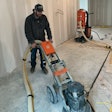
Continuing our series with a roadmap for how to “break the tradesman’s curse” to grow your business (see the article from the October/November 2023 issue here, Part 1: Standard Operating Procedures and Part 2: Project Analysis and Part 3: Setting Quality Standards) …
Are you ready to ditch status quo and take your business to the next level? We have the opportunity to redefine what success looks like in the wood floor industry! We will break down key foundational elements we can build upon each pillar to strengthen your business. I never want to sugarcoat the challenges to implement a winning business structure—taking it step by step is the key to success!
The concept of key performance indicators (KPI’s) sounds great, but what does that mean? Is it just some trendy business talk or is it something even a small wood flooring business could benefit from? In Part 2 of this blog series, Project Analysis, we did a deep dive into what numbers to track and how to track them. We will be using these numbers to develop the KPI’s that will help you strategize and hit the goals you set for your company. You won’t even need lattes or skinny jeans to make this happen (unless you think they would be helpful).
The No. 1 benefit of tracking KPI’s is for strategy and accountability. What factors drive revenue and net profit?
Key Performance Indicators to track annually:
1) Booking rate: This is the lead to quote/estimate ratio. Example: 57 quotes divided by 95 leads equals a 60% booking rate: 57÷95 = 0.6 = 60%
2) Close rate: This is the quote/estimate to projects won ratio. Example: 40 projects won divided by 57 projects quoted equals a 70% close rate: 40÷57 = 0.7 = 70%
3) Average ticket: This is projects won to total revenue ratio. Example: $400,000 revenue divided by 40 projects equals a $10,000 average ticket: $400,000÷400 = $10,000
4) Gross profit margin: This is the gross profit to revenue ratio. Use this number to make sure all overhead costs are covered to hit net profit numbers. Example: $400 gross profit divided by $1,000 revenue equals 40% gross profit margin: $400÷$1,000 = 0.4 (refer to blog series Part 2: Projects Analysis for more information on your profit margin)
Million-dollar annual revenue example:
We will use the numbers above to figure out what numbers we need to go from $400,000 revenue to $1 million in revenue.
1) Average ticket: Use these numbers to figure out how many projects you will need to win. Example: $1 million revenue divided by $10,000 average ticket equals 100 projects needed: 1,000,000÷10,000 = 100
2) Close rate: Use these numbers to figure how many quotes/estimates you’ll need to hit your revenue goal. Example: 100 projects divided by 70% close rate equals 142 quotes/estimates needed: 100÷0.7 = 142
3) Booking rate: Use these numbers to figure how many leads you’ll need to book quotes/estimates for. Example: 142 quotes/estimates divided by 60% booking rate equals 236 leads needed: 142÷0.6 = 236
4) Gross profit margin: Use these numbers to make sure projects are sold at a high enough margin to cover all overhead expenses to hit net profit targets. Example: $1 million revenue with 40% gross profit margin could give the company, based on total revenue, 60% cost of goods sold, 30% overhead, and 10% net profit. That would give the company $100,000 net profit. If the gross profit margin drops, net profit targets will not be met. If gross profit margins go up, the company can earn more net profit. Keep in mind owner/operator wages are not included in net profit.
Million-dollar revenue goals example:
Qualified leads: 236 yearly, 20 monthly, 5 weekly
Estimates/quotes: 142 yearly, 12 monthly, 3 weekly
Closed sales: 100 yearly, 9 monthly, 2 weekly
Now that we have our KPI’s, we can create strategy to hit our business goals! These are the foundational KPI’s for a home service business, but you can create your own KPI’s that are unique to your company to stay on track. It’s important to remember not too create too many KPI’s, because we don’t want to get paralysis analysis. That’s when we are using too many key numbers to track that we lose focus of what really drives the business forward. Other numbers are important, but we will use many other numbers to create score cards for our team.
If you need resources to implement KPI’s into your business structure, contact me and we can get you set up and on track!
Stay tuned for the next blog in this series: Part 5: Score Cards. We will take a dive into how to develop score cards that will give your team a clear path to achieve their goals and collectively achieve the goals and milestones you’ve set for the company. Let’s create a business structure where everyone wins!
Editor's Note:
Be sure to read the WFB Magazine article “Building Systems to Break the ‘Tradesman’s Curse’ for Growth in Your Wood Flooring Business” and all of Matt's blog posts in this series:
Breaking the “Tradesman’s Curse” for Growth, Part 1: Creating Your Standard Operating Procedures
Breaking the 'Tradesman’s Curse' for Growth, Part 2: Project Analysis
Breaking the 'Tradesman’s Curse' for Growth, Part 3: Setting Quality Standards
Breaking the 'Tradesman’s Curse' for Growth, Part 4: Key Performance Indicators
Breaking the 'Tradesman’s Curse' for Growth, Part 5: Employee Scorecards
Breaking the 'Tradesman’s Curse' for Growth, Part 6: Performance Pay
Breaking the 'Tradesman’s Curse' for Growth, Part 7: The Power of Cash Flow


































